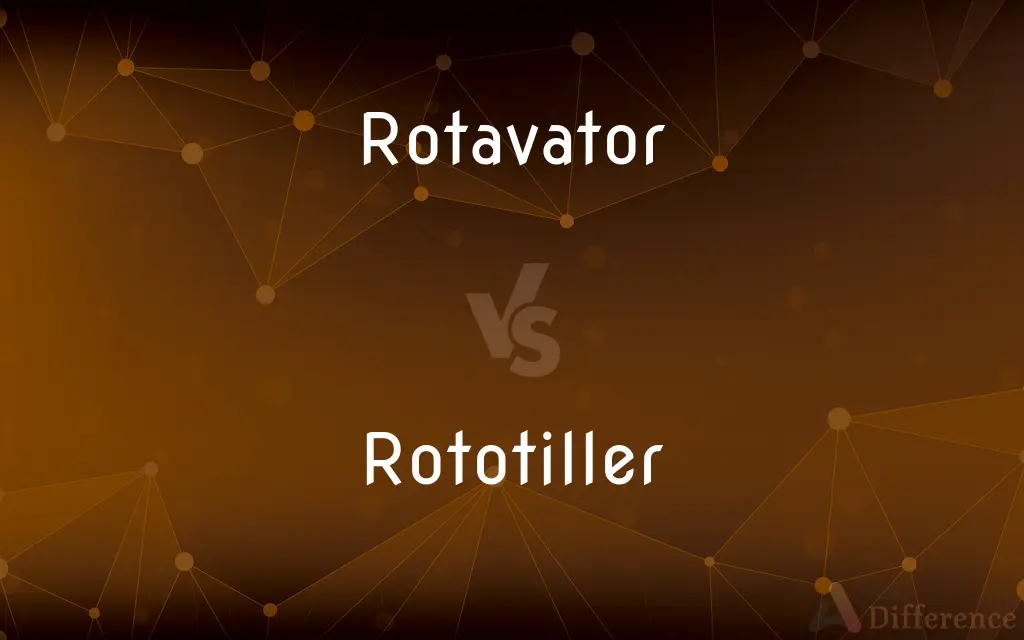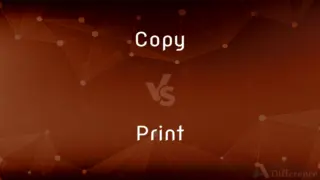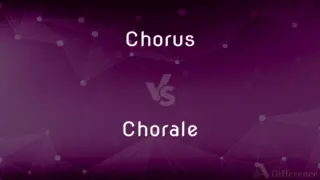Rotavator vs. Rototiller — What's the Difference?
By Tayyaba Rehman & Urooj Arif — Updated on April 24, 2024
Rotavators and rototillers both prepare soil but differ in design; rotavators are typically more heavy-duty with a self-propelled mechanism, while rototillers are often smaller and manually pushed.

Difference Between Rotavator and Rototiller
Table of Contents
ADVERTISEMENT
Key Differences
Rotavators are robust, self-propelled machines that deeply cultivate soil, equipped with their own engine and drive system. On the other hand, rototillers, although similar in function, are usually smaller and need to be pushed manually or may have a very basic propulsion system.
Rotavators often come with multiple attachments and can perform a variety of soil preparation tasks, from turning soil to aerating and removing weeds. In contrast, rototillers are simpler in design and primarily used for turning and breaking up soil.
The design of a rotavator includes a set of rotating blades or tines under a protective casing, which digs deeply into the soil. Whereas rototillers have similar blades but are typically less robust and may not penetrate as deeply, depending on the model.
Rotavators are better suited for larger or more challenging landscaping projects, capable of handling tougher terrain and more extensive areas. Rototillers, however, are more appropriate for smaller gardens or softer soils where deep cultivation is not necessary.
In terms of ease of use, rotavators, with their self-propulsion, require less physical effort from the user, making them preferable for larger or more frequent jobs. Rototillers, while requiring more manual effort, are lighter and easier to maneuver in tight spaces.
ADVERTISEMENT
Comparison Chart
Propulsion
Self-propelled
Manual or basic propulsion
Suitability
Large, tough areas
Smaller, softer areas
Soil Penetration
Deep cultivation
Lighter, surface cultivation
Ease of Use
Less physical effort, heavier
More physical effort, lighter
Versatility
Multiple attachments, various tasks
Mainly for soil turning
Compare with Definitions
Rotavator
A self-propelled machine used for breaking up and aerating soil.
The farmer used a rotavator to prepare the field for planting.
Rototiller
A garden tool for turning over the soil, often manually propelled.
She used a rototiller to aerate the garden beds each spring.
Rotavator
A heavy-duty agricultural implement.
His new rotavator has made crop preparation much faster.
Rototiller
Suitable for small to medium gardens.
Their new rototiller was perfect for the community garden plots.
Rotavator
A gardening tool that deeply cultivates soil with rotating blades.
The rotavator churned through the compact soil with ease.
Rototiller
Ideal for regular garden maintenance.
The rototiller made quick work of preparing the soil for seeding.
Rotavator
Used for large-scale gardening and farming.
Renting a rotavator saved them a lot of time on the large garden.
Rototiller
Simpler and usually lighter than a rotavator.
The lightweight rototiller was easy for anyone to use.
Rotavator
Typically more complex and powerful than a tiller.
The rotavator handled the rocky soil much better than a standard tiller.
Rototiller
Requires physical effort to operate.
He enjoyed the workout he got from using the rototiller in his yard.
Rotavator
A machine with rotating blades for breaking up or tilling the soil.
Rototiller
A motor-driven machine with rotating blades for breaking up or tilling the soil.
Rotavator
A machine with rotating blades designed to break up or till soil.
Rototiller
A motorized rotary cultivator.
Rototiller
(US) a motorized cultivator having rotating blades
Common Curiosities
Can a rototiller handle rocky soil?
Rototillers can handle moderately tough soils but are less effective in rocky conditions compared to rotavators.
Do rotavators come with different attachments?
Yes, rotavators often come equipped with various attachments to handle multiple gardening tasks.
Are there electric models of rototillers?
Yes, there are both electric and gas-powered models of rototillers, offering options for different preferences.
What is the main purpose of a rotavator?
A rotavator is primarily used for deep soil cultivation and is suitable for large-scale agricultural tasks.
How much effort is required to operate a rotavator?
Rotavators are self-propelled, requiring less manual effort compared to rototillers.
Is a rototiller easy to store?
Yes, due to their smaller size and lighter weight, rototillers are generally easier to store than rotavators.
Are rototillers suitable for large farms?
Rototillers are typically more suited to smaller gardens and may not be efficient for large-scale farming.
How often should I maintain my rototiller?
Regular maintenance, such as blade sharpening and engine checks, is recommended to keep the rototiller in good working condition.
What type of soil is best for a rototiller?
Rototillers work best in softer, smaller areas where deep cultivation is not necessary.
What safety features should I look for in a rotavator?
Look for safety shields over the blades, emergency shutoff features, and sturdy construction.
Which is more durable, a rotavator or a rototiller?
Rotavators are generally more durable and built for tougher soil and longer use.
Can I use a rototiller for weeding?
Yes, rototillers can be effective for weeding, especially in softer soils.
Can a rotavator be used on wet soil?
While it's possible, it's not recommended to use a rotavator on very wet soil as it can compact the soil and damage the machine.
What is the cost difference between a rotavator and a rototiller?
Rotavators are usually more expensive due to their larger size, power, and versatility.
How do I choose between a rotavator and a rototiller?
Choose based on the size of the area to be cultivated, the soil type, and the depth of cultivation needed.
Share Your Discovery

Previous Comparison
Copy vs. Print
Next Comparison
Chorus vs. ChoraleAuthor Spotlight
Written by
Tayyaba RehmanTayyaba Rehman is a distinguished writer, currently serving as a primary contributor to askdifference.com. As a researcher in semantics and etymology, Tayyaba's passion for the complexity of languages and their distinctions has found a perfect home on the platform. Tayyaba delves into the intricacies of language, distinguishing between commonly confused words and phrases, thereby providing clarity for readers worldwide.
Co-written by
Urooj ArifUrooj is a skilled content writer at Ask Difference, known for her exceptional ability to simplify complex topics into engaging and informative content. With a passion for research and a flair for clear, concise writing, she consistently delivers articles that resonate with our diverse audience.














































